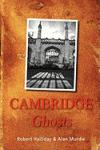
As well as being one of the most fascinating cities in Britain, Cambridge, according to Robert Halliday and Alan Murdie, is one of the most haunted. That is not surprising given somewhere so old and imbued with history, and the authors have produced an enjoyable popular tour of its spooky side.
This is an updated and extensively rewritten version of the authors’ The Cambridge Ghost Book, published in 2000. They have also restructured it: the original listed each location alphabetically on the contents page whereas this edition categorises them according to whether the featured ghosts are in colleges, found in city centre premises, are out in the “suburbs”, or are wider afield in the district. This is a useful method of organisation, particularly if used on a walk, but the drawback is that it is not possible to find a particular site at a glance without searching the entire section. Perhaps the next edition could combine the same general structure with a separate index.
The authors have been busy collecting stories in the last ten years, and there are some additions to those in the original edition. The major change is a new section listing places of interest outside Cambridge but within easy striking distance, such as The Old Vicarage at Grantchester, Madingley Hall, Sawston Hall and that staple the Old Ferry Boat at Holywell. The last was investigated – and the myth inadvertently created – by the late Tony Cornell (Cambridge graduate and life-long resident), to whom the authors have dedicated the book.
As well as the places they discuss personalities, notably M R James and T C Lethbridge. Cambridge is of course firmly linked to the Society for Psychical Research, and the authors have made use of the Society’s archives which are housed at Cambridge University Library. They consider the early SPR and those of its major figures who were associated with the university, and particularly Trinity College.
They also cover the origins of the Ghost Club (which is still in existence) at Trinity in 1851. I would dispute the assertion that the Ghost Club is the oldest continuously running paranormal research society in the world, and I say this diffidently given Alan Murdie’s long association with the Club. I would argue that its history over the last 160 years is one of several organisations with the same name, and that the honour of world’s longest continuously running research society should go to the SPR. A minor error is the spelling of Frederick Warrick’s name (as in the Perrott-Warrick fund). Perhaps by now he, wherever he is, is used to it being spelled ‘Warwick’.
One other notable difference between this volume and its predecessor is that the very attractive line drawings have been replaced by photographs. The result is that Cambridge Ghosts is more extensively illustrated, but perhaps at the expense of atmosphere. The text though is clearly and entertainingly written, and this is an attractive and informative guidebook for resident and visitor alike.

